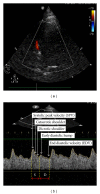Ultrasound for the anesthesiologists: present and future
- PMID: 24348179
- PMCID: PMC3856172
- DOI: 10.1155/2013/683685
Ultrasound for the anesthesiologists: present and future
Abstract
Ultrasound is a safe, portable, relatively inexpensive, and easily accessible imaging modality, making it a useful diagnostic and monitoring tool in medicine. Anesthesiologists encounter a variety of emergent situations and may benefit from the application of such a rapid and accurate diagnostic tool in their routine practice. This paper reviews current and potential applications of ultrasound in anesthesiology in order to encourage anesthesiologists to learn and use this useful tool as an adjunct to physical examination. Ultrasound-guided peripheral nerve blockade and vascular access represent the most popular ultrasound applications in anesthesiology. Ultrasound has recently started to substitute for CT scans and fluoroscopy in many pain treatment procedures. Although the application of airway ultrasound is still limited, it has a promising future. Lung ultrasound is a well-established field in point-of-care medicine, and it could have a great impact if utilized in our ORs, as it may help in rapid and accurate diagnosis in many emergent situations. Optic nerve sheath diameter (ONSD) measurement and transcranial color coded duplex (TCCD) are relatively new neuroimaging modalities, which assess intracranial pressure and cerebral blood flow. Gastric ultrasound can be used for assessment of gastric content and diagnosis of full stomach. Focused transthoracic (TTE) and transesophageal (TEE) echocardiography facilitate the assessment of left and right ventricular function, cardiac valve abnormalities, and volume status as well as guiding cardiac resuscitation. Thus, there are multiple potential areas where ultrasound can play a significant role in guiding otherwise blind and invasive interventions, diagnosing critical conditions, and assessing for possible anatomic variations that may lead to plan modification. We suggest that ultrasound training should be part of any anesthesiology training program curriculum.
Figures







References
-
- Kline JP. Ultrasound guidance in anesthesia. AANA Journal. 2011;79(3):209–217. - PubMed
-
- Falyar CR. Ultrasound in anesthesia: applying scientific principles to clinical practice. AANA Journal. 2010;78(4):332–340. - PubMed
-
- Hatfield A, Bodenham A. Ultrasound: an emerging role in anaesthesia and intensive care. British Journal of Anaesthesia. 1999;83(5):789–800. - PubMed
-
- Kristensen MS. Ultrasonography in the management of the airway. Acta Anaesthesiologica Scandinavica. 2011;55(10):1155–1173. - PubMed
-
- Stefanidis K, Dimopoulos S, Nanas S. Basic principles and current applications of lung ultrasonography in the intensive care unit. Respirology. 2011;16(2):249–256. - PubMed
Publication types
MeSH terms
LinkOut - more resources
Full Text Sources
Other Literature Sources

